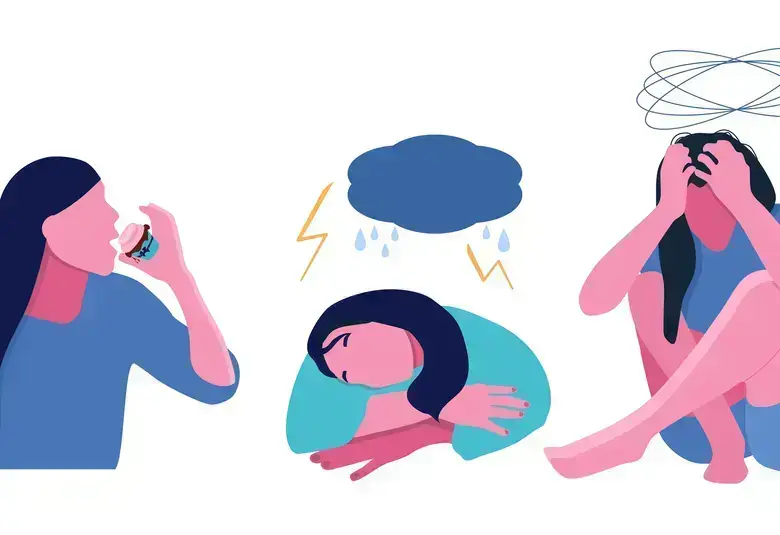There are several known epidemiological differences between the genders in psychiatric disorders. Does this also extend to differences in responses to treatment?
정신장애들에서 성별에 따라 몇 가지 역학적 차이가 있는 것으로 알려져 있습니다. 이 차이가 치료 반응의 차이로도 이어질까요?
Depression and its treatment
우울증과 그에 대한 치료
No good evidence for different therapeutic effects on women and men with MDD
주요우울장애를 겪는 여성과 남성의 치료 효과가 각각 다름을 입증하는 명확한 증거는 없습니다.
The heritability of major depressive disorder (MDD) is greater for women than men.1 Likewise, its lifetime prevalence is higher for women.2 Although the difference in incidence between the genders diminishes in post-menopausal women, the severity, disease duration and rates of recurrence are generally higher for women, so their disease course is often a more severe one. The effectiveness of antidepressants in treating MDD of at least moderate severity is well established.3 Several systematic reviews and meta-analyses have also investigated whether there are differences in the efficacy of antidepressant therapies in women and men. These demonstrate no good evidence for different therapeutic effects in women and men, or for a change in efficacy related to menopausal status in women.
Bipolar I disorder and its treatment
양극성 I형 장애와 이에 대한 치료
Women with bipolar I disorder often have a more severe disease course than men
양극성 I형 장애가 있는 여성 환자는 보통 남성 환자에 비해 질병 경과가 더 심각한 경우가 많습니다.
The lifetime prevalence of bipolar I disorder is around 0.6%, a prevalence about the same in women and men. Despite this equal prevalence, however, bipolar I is a diverse disorder, with a great deal of inter-individual disease variation, and women tend to demonstrate a more severe disease course than men.5 Thus, women with bipolar I are more likely to attempt suicide,6 have greater rates of in-patient admissions,7 and are more likely to experience rapid cycling and mixed episodes,8 both of which are indicative of a more severe disease course. Women with bipolar I disorder therefore often show a worse prognosis of their disorder than do men. This difference between the genders cannot, however, be explained by any difference in their response to pharmacotherapy for manic episodes. An individual patient meta-analysis in mania showed slightly better treatment efficacy in men than women, but these differences did not reach statistical significance. This effect was also independent of patient age greater or less than 47 years (a proxy for menopausal status).
양극성 I형 장애의 생애 유병률은 약 0.6%로, 남성과 여성에서의 유병률이 비슷한 수준입니다. 그러나 유병률은 비슷함에도 불구하고 양극성 I형 장애는 개인별로 차이가 큰 다양성 높은 질환으로서, 남성보다 여성의 질병과정이 더 심각한 경향이 있습니다.5 따라서 양극성 I 장애를 겪는 여성 환자는 자살 시도 가능성이 더 높고,6 입원률도 더 높으며,7 보다 심각한 질병 경과의 지표가 되는 빠른 삽화 주기(rapid cycling) 및 혼재성 삽화(mixed episode)를 겪을 가능성 또한 높습니다.8 따라서 양극성 I형 장애 여성 환자는 남성에 비해 질환의 예후가 더 나쁜 경우가 많습니다. 그러나 이러한 성별에 따른 차이가 조증 삽화의 약물 요법에 대한 반응의 차이로 설명될 수는 없습니다. 조증에 관한 개별 환자 메타 분석에 따르면 여성 대비 남성의 치료 효능이 약간 높기는 하지만, 이 차이가 통계적으로 유의미한 수준에 이르지는 못했습니다. 또한, 이 치료 효과는 폐경기 상태의 대리값(proxy)인 47세 이상 또는 이하 여부와는 무관했습니다.
Schizophrenia and treatment with antipsychotics
조현병과 항정신병약 치료
Men showed a larger placebo response than women in trials of antipsychotics
항정신병약 임상 시험에서 남성 환자는 여성에 비해 더 큰 위약 반응을 보였습니다.
Potential difference in the effects of antipsychotics on women and men with schizophrenia were investigated using data from the NewMeds database.9,10 These data from 64 studies, involving 25,900 patients, did show a better treatment response (comparing active treatment with placebo) in women than in men. However, this difference was attributable to a larger placebo response in men, which reduced the apparent treatment effect when compared with women, who showed a smaller placebo response. The reason for this difference between the genders is unknown; but was robust across different studies. One possible explanation is a greater response of male patients to the social and environmental changes (and comforts) produced by being included in a trial cohort (leading to an enhanced placebo response). All of these results merit further investigation, so that treatments can increasingly be tailored to individual patients.
뉴메즈(NewMeds) 데이터베이스를 이용한 연구에서 남녀 조현병 환자에게서 나타나는 항정신병약 효과의 잠재적 차이를 살펴보았습니다.9,10 환자 25,900명을 대상으로 실시한 연구 64건의의 데이터에 따르면 남성에 비해 여성에게서 더 높은 치료 반응(적극 치료(active treatment)와 위약의 효과를 비교)이 나타났습니다. 그러나 이러한 차이가 발생한 원인은 여성은 위약 반응이 낮은 반면 남성 환자는 위약 반응이 높아 명확한(apparent) 치료 효과가 감소했기 때문이기도 합니다. 이러한 성별에 따른 차이의 원인은 밝혀지지 않았으나, 여러 연구들에서도 확연하게(robust) 나타났습니다. 임상 시험 집단에 속해 있다는 사실로 인한(높은 위약반응을 초래) 사회적 및 환경적 변화(그리고 편안함)로 인해 위약 반응이 더 높아졌다는 해석도 가능합니다. 이러한 결과들은 추가적으로 연구할 만한 가치가 있으며, 그 결과로 개별 환자들에 대한 맞춤화 치료가 증가될 수 있을 것입니다.
본 자료는 Global Lundbeck 의학부에서 선별한 콘텐츠이며, 한국룬드벡의 의견과 다를 수 있습니다




